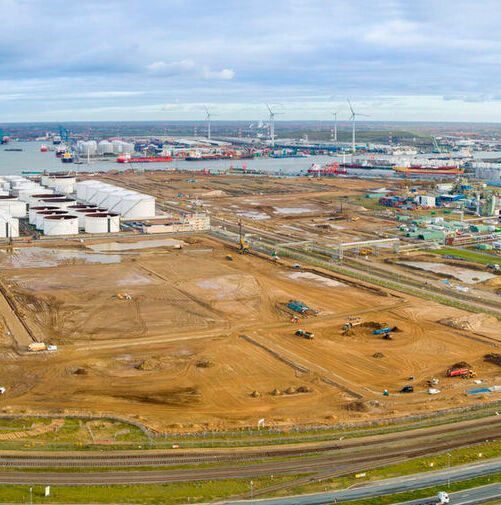Project One Coming Soon: Europe’s Most Sustainable Cracker!
Related Vendors
In line with the goals of the European Green Deal, Ineos Olefins Belgium has plans to create the region’s most eco-friendly and sustainable cracker project ever at a whooping cost of 3+ billion euros. The landmark ‘Project One’ will be located at the port of Antwerp in Belgium and will make use of the latest technologies to produce ethylene with the lowest carbon footprint in all of Europe.

Project One has already attracted eyeballs from across the globe and the core reason behind this is its aim to be the most sustainable cracker in Europe! But that’s not all, with a hefty investment of 3+ billion euros, it is also claimed to be the largest investment in the region’s chemical sector in the past 2 decades.
The chemical company Ineos Olefins Belgium is behind the development of this mega project which intends to convert odorless ethane gas into ethylene, an essential element used to produce superior-quality products for various industries such as energy, medical, automotive and construction. With a capacity to produce 14,50,000 tonnes of ethylene annually, the cracker will adopt the most revolutionary technologies to make sure that its carbon footprint per ton of High Value Chemicals (HVC) will be less than half compared to the top 10 % crackers in all of Europe. Thus, achieving the lowest carbon footprint in the region.
Designing the plant
The French company Technip Energies secured a contract by Ineos Olefin for carrying out the feed (Front End Engineering Design), licensing as well as supplying its proprietary equipment for the project, according to a release by the company. Under its supervision, the project opted for a modular design in which modules of the plant including the furnaces will be developed off-site under controlled conditions and then be transported by sea to the actual site in Belgium. Once the modules are installed at the site, the produced ethylene will be transported through pipelines to the customers who could save 2 million tonnes of CO2 emissions annually.
The modular plant ensures superior quality of equipment, flexibility to integrate new and sustainable technologies, helps in reducing capex and also ends up saving significant construction time. Also, the EPC firm Tecnicas Reunidas won a contract for project management, engineering, procurement and construction management and supervision services for Project One under which it is also designing large-scale modules, mentions a release by Tecnicas Reunidas.
In addition to this, for engineering, procurement, and construction management (Epcm) services, the engineering services company Wood has secured a 100 million dollar-plus-contract which will focus on the outside battery limit facilities for the project and follows the successful completion of front-end engineering design for the facility. Wood’s integrated project management team will also continue to oversee the project, working closely with the Ineos project team, shares a press release by Wood.
Sustainable technologies
Technip Energies’ low-carbon ethane cracking technology was selected for the development of the plant which aims to achieve a CO2 footprint less than 50 % of the best 10 % of European crackers and three times lower than the average European steam cracker.
Project One also plans to incorporate innovative technologies such as carbon capture and storage (CCS) as well as electric furnaces into the project once the technology proves to be more energy efficient and further develops in the sector. A conscious effort is also being made at the design stage to utilize the coolness of the raw materials and heat from the crackers to save energy. On inquiring multiple times about the other different kinds of technologies to be used in Project One, we didn’t receive any inputs from Ineos.
The ‘hydrogen’ factor
The conversion process of ethane to ethylene will be made much more efficient at the plant as hydrogen will be produced as a by-product and be used as a clean fuel to power the cracker’s furnaces. For the future, the firm is also making significant investments in the hydrogen technology which will help it to utilize green hydrogen entirely for feeding the project’s cracking ovens and steam generators, thus making it a net-zero project. Ineos has also entered into three large renewable offshore wind energy contracts with Eneco, Engie and RWE to meet the energy requirements of this plant.
Official ceremony and current status of Project One
In December last year, an official ceremony was conducted to mark the start of the construction phase for Project One. High level dignitaries
including Bart De Wever, the mayor of Antwerp and John Mc Nally, CEO of Ineos Project One attended the event in which a symbolic sheet pile was placed into the ground in the port of Antwerp.
Recently, Ineos Olefins Belgium secured a massive funding of 3.5-billion-euros from 21 commercial banks for establishing Project One. A press release by the firm states that it comprises of 1.5 billion euros of uncovered debt, 1.2 billion euros of covered facilities from export credit agencies UKEF, Cesce and Sace; and an 800 million euro covered tranche of which up to 500 million euros is guaranteed by Gigarant (a vehicle of the Flemish Government that provides loan guarantees).
According to the website of Project One, construction of the cracker is scheduled to commence in the first half of 2023 and the installations will go into operation by mid-2026.
(ID:49317558)




:quality(80)/p7i.vogel.de/wcms/13/43/1343c7429d2e88c942c6b7fee6d4321f/0110711787.jpeg)
:quality(80)/p7i.vogel.de/wcms/a7/09/a70912acec44522a9b6f4478d2dc4c48/0110696306.jpeg)
:quality(80)/p7i.vogel.de/wcms/1d/7c/1d7c6361016ae037b2e75f9a7af2bd1c/0110678701.jpeg)
:quality(80)/p7i.vogel.de/wcms/fc/24/fc245c95d640550833b8940d0afe2449/0110626280.jpeg)
:quality(80)/p7i.vogel.de/wcms/f0/4c/f04c1ccb183270518e50425558f1e5fd/0110721926.jpeg)
:quality(80)/p7i.vogel.de/wcms/4f/ac/4fac423b36136c6469c1f637b8012fb3/0110712491.jpeg)
:quality(80)/p7i.vogel.de/wcms/ff/ad/ffad5ac074591b05c1c102af84d062f6/0110696317.jpeg)
:quality(80)/p7i.vogel.de/wcms/be/a8/bea8438c0202ac377a72b1de8d932033/0110679533.jpeg)
:quality(80)/p7i.vogel.de/wcms/21/e2/21e2db35ca3ae77de36a9c45d4af8757/0110557579.jpeg)
:quality(80)/p7i.vogel.de/wcms/a0/ec/a0ecc3759144749ae34fc69ff34a2bef/0109635835.jpeg)
:quality(80)/p7i.vogel.de/wcms/0a/95/0a9539d21db5621ea6d89a29761cb089/0108737015.jpeg)
:quality(80)/p7i.vogel.de/wcms/3b/60/3b605642a596077f5df363f2ab06b515/0110089797.jpeg)
:quality(80)/p7i.vogel.de/wcms/57/72/57726427a6e7190bcb991ce4fe276b07/0110657493.jpeg)
:quality(80)/p7i.vogel.de/wcms/29/ec/29ec582c3232dbada4a0d13444bae7c0/0110655319.jpeg)
:quality(80)/p7i.vogel.de/wcms/1b/38/1b3892a575ae092a493b03a2e49b6e83/0110598813.jpeg)
:quality(80)/p7i.vogel.de/wcms/f7/c3/f7c325cdd652494b517a2e5983cc9aa1/0110569237.jpeg)
:quality(80)/p7i.vogel.de/wcms/ea/e0/eae0cbb4dadc45459b3d45b3a65f585e/0110486024.jpeg)
:quality(80)/p7i.vogel.de/wcms/66/05/6605972cc9ae0b97eb8cf3378d21092d/0109937656.jpeg)
:quality(80)/p7i.vogel.de/wcms/97/81/9781aebc274c6b1b1838388a5b19b1e7/0109901763.jpeg)
:quality(80)/p7i.vogel.de/wcms/d8/67/d8671d8068c0d053ad243bebe77d6aca/0109685598.jpeg)
:quality(80)/p7i.vogel.de/wcms/4a/bd/4abdc5aa177ea86c1a856c79c290ca22/0110713278.jpeg)
:quality(80)/p7i.vogel.de/wcms/4a/00/4a00a39ba3a9a086d9508b81cc24061c/0110654682.jpeg)
:quality(80)/p7i.vogel.de/wcms/74/4c/744c7eb8da584363438aa7667e2a98f1/95230992.jpeg)
:quality(80)/images.vogel.de/vogelonline/bdb/1797900/1797927/original.jpg)
:quality(80)/images.vogel.de/vogelonline/bdb/1797600/1797603/original.jpg)
:fill(fff,0)/images.vogel.de/vogelonline/companyimg/2000/2093/65.jpg)
:fill(fff,0)/p7i.vogel.de/companies/5f/98/5f98fbb2e7bf2/05-trm-filter-logo-with-slogan-en-alt.png)
:fill(fff,0)/images.vogel.de/vogelonline/companyimg/107300/107301/65.jpg)
:quality(80)/images.vogel.de/vogelonline/bdb/1919600/1919654/original.jpg)
:quality(80)/images.vogel.de/vogelonline/bdb/1896400/1896495/original.jpg)